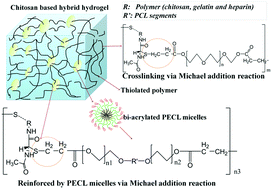High mechanical strength chitosan-based hydrogels cross-linked with poly(ethylene glycol)/polycaprolactone micelles for the controlled release of drugs/growth factors†
Abstract
High mechanical strength hydrogels without burst release are known to be beneficial to deliver bioactive molecules including drugs and growth factors. Herein, chitosan-based hydrogels are fabricated by the covalent attachment of poly(ethylene glycol) diacrylate (PEGDA) to thiol groups of thiolated natural polymers via Michael addition reaction under physiological conditions. Poly(ethylene glycol-b-caprolactone-b-ethylene glycol) (PECL) micelles bearing double bonds act as both fillers and chemical cross-linkers to mechanically reinforce chitosan-based hydrogels, which is confirmed by the results of rheological behavior and compressive strength measurements. Indomethacin (IMC) and/or basic fibroblast growth factor (bFGF) are/is entrapped into the PECL micelle cross-linked hydrogel network primarily through hydrophobic interaction and specific affinity to thiolated heparin, respectively. After a relatively quick initial release, rather than an initial burst commonly occurring in conventional hydrogels based on drug delivery systems, IMC and/or bFGF are/is released from these PECL micelle cross-linked hydrogels at a slower rate until a steady state is reached. The release rate of IMC and/or bFGF could be readily tuned by varying the micelle amount and the thiolated heparin content in a polymer matrix.



 Please wait while we load your content...
Please wait while we load your content...